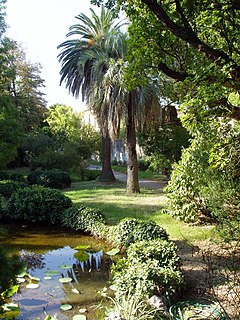
The Texas State Capitol is the capitol building and seat of government of the American state of Texas. Located in downtown Austin, Texas, the structure houses the offices and chambers of the Texas Legislature and of the Governor of Texas. Designed in 1881 by architect Elijah E. Myers, it was constructed from 1882 to 1888 under the direction of civil engineer Reuben Lindsay Walker. A $75 million underground extension was completed in 1993. The building was added to the National Register of Historic Places in 1970 and recognized as a National Historic Landmark in 1986.

Starr Family Home State Historic Site is a 3.1-acre (1.3 ha) historical site operated by the Texas Historical Commission in downtown Marshall, Texas. It was listed on the National Register of Historic Places in 1979. The museum was made a Recorded Texas Historic Landmark in 1986. On January 1, 2008, the site was transferred from the Texas Parks and Wildlife Department to the Texas Historical Commission.

Sonnenberg Gardens and Mansion State Historic Park is a 50-acre (20 ha) state park located at 151 Charlotte Street in Canandaigua, New York, at the north end of Canandaigua Lake, in the Finger Lakes region of Upstate New York. The house and gardens are open to the public every day, May through October.
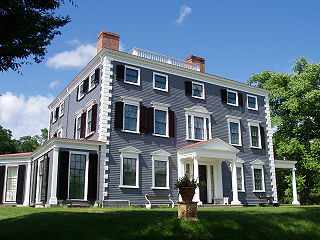
The Codman House is a historic house set on a 16-acre (6.5 ha) estate at 36 Codman Road, Lincoln, Massachusetts. Thanks to a gift by Dorothy Codman, it has been owned by Historic New England since 1969 and is open to the public June 1–October 15 on the second and fourth Saturdays of the month. An admission fee is charged.
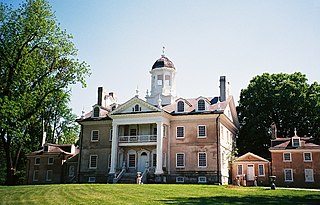
Hampton National Historic Site, in the Hampton area north of Towson, Baltimore County, Maryland, USA, preserves a remnant of a vast 18th-century estate, including a Georgian manor house, gardens, grounds, and the original stone slave quarters. The estate was owned by the Ridgely family for seven generations, from 1745 to 1948. The Hampton Mansion was the largest private home in America when it was completed in 1790 and today is considered to be one of the finest examples of Georgian architecture in the U.S. Its furnishings, together with the estate's slave quarters and other preserved structures, provide insight into the life of late 18th-century and early 19th-century landowning aristocracy. In 1948, Hampton was the first site selected as a National Historical Site for its architectural significance by the U.S. National Park Service. The grounds were widely admired in the 19th century for their elaborate parterres or formal gardens, which have been restored to resemble their appearance during the 1820s. Several trees are more than 200 years old. In addition to the mansion and grounds, visitors may tour the overseer's house and slave quarters.

Hyde Park is a neighborhood and historic district in Austin, Texas. Located in Central Austin, Hyde Park is defined by W. 38th Street to the south, W. 51st Street to the north, Duval Street to the east, and Guadalupe Street to the west. It is situated just north of the University of Texas and borders the neighborhoods of Hancock and North Loop.
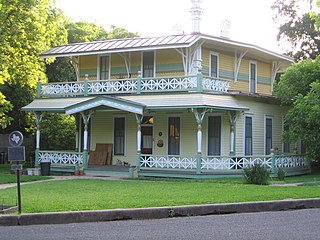
The Shadow Lawn Historic District is a historic district in central Austin, Texas that boasts a cohesive collection houses built in the southeast portion of Hyde Park during the late 1920s and 1930s.

The Tinker Swiss Cottage is a historic house museum and park in Rockford, Illinois, United States. It was built as a personal residence by Robert Hall Tinker between 1865-1870. It is now a popular destination for school groups, general tours, and for rentals.

The John Nance Garner House, located in Uvalde, Texas, United States, was the home of American Vice-President John Nance Garner and his wife Ettie from 1920 until Ettie's death in 1948. Garner, a native of Uvalde, lived there until 1952, when he moved to a small cottage on the property and donated the main house to the City of Uvalde as a memorial to Mrs. Garner. The house is now known as the Briscoe-Garner Museum, and also known as the Ettie R. Garner Memorial Building.
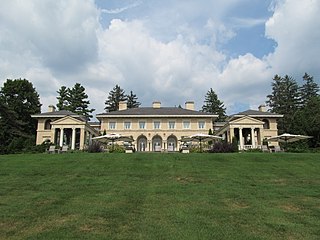
Wheatleigh is a historic country estate on West Hawthorne Road in Stockbridge, Massachusetts, United States. Built in 1893 to a design by Peabody and Stearns, it is one of the few surviving great Berkshire Cottages of the late 19th century, with grounds landscaped by Frederick Law Olmsted. Its estate now reduced to 22 acres (8.9 ha), Wheatleigh was listed on the National Register of Historic Places in 1982. It is now operated as a hotel.

The Eudora Welty House at 1119 Pinehurst Street in Jackson, Mississippi was the home of author Eudora Welty for nearly 80 years. It was built by her parents in 1925. In it she did all her writing, in an upstairs bedroom. Welty created the garden over decades. The house was first declared a Mississippi Landmark in 2001, added to the National Register of Historic Places in 2002, and declared a National Historic Landmark in 2004. This was part of a raised awareness of the significance of authors and literary life in the United States.

The Masonic Home and School of Texas was a home for widows and orphans in what is now Fort Worth, Texas from 1889 to 2005. The first superintendent was Dr. Frank Rainey of Austin, Texas. Starting in 1913, it had its own school system, the Masonic Home Independent School District.

Mayfield is a small community in northeast Baltimore, Maryland. It is bounded by Erdman Avenue on the south, Chesterfield Avenue on the north, Crossland Avenue on the east and Lake Montebello on the north and west. Homeowners belong to the Mayfield Improvement Association.

The Minnesota Home School for Girls was a reformatory in Sauk Centre, Minnesota, United States. It was Minnesota's first single-sex reformatory for girls from its establishment in 1911 to 1967, when it switched to a coeducational model and shortened its name to the Minnesota Home School. The facility closed in 1999. The campus was designed on the Cottage Plan, with dispersed buildings in a bucolic setting, by Minnesota state architect Clarence H. Johnston Sr. The site has been converted to a veteran care center called Eagle's Healing Nest.

This is a list of the National Register of Historic Places listings in Henrico County, Virginia.

The Pfau–Crichton Cottage, best known as Chinaberry, is a historic cottage in Mobile, Alabama. The 1 1⁄2-story, wood-frame, Gulf Coast cottage was completed in 1862. The house was built by the Pfau family, but its best known resident was Miss Anne Randolph Crichton, known for the elaborate gardens that she developed on the property. She enlisted in the Navy at the outbreak of World War I and continued her service until retirement, in the 1950s. She traveled extensively in Europe during the 1930s, maintaining scrapbooks that recorded her visits to various art museums, gardens, and monuments. She was the last direct descendant of Hugh Randolph Crichton, the founder of the Mobile County town of Crichton. The house was added to the National Register of Historic Places on October 18, 1984 as a part of the 19th Century Spring Hill Neighborhood Thematic Resource listing of well-preserved buildings that represent the historical development of what was once the village of Spring Hill.

Ashton Villa is a fully restored, historic home located on the corner of 24th and Broadway in Galveston, Texas, United States. Constructed in 1859, it was one of the first brick structures in Texas.

Mayfield Cottage is a historic plantation house located near the grounds of Central State Hospital near Petersburg, Dinwiddie County, Virginia. It was built about 1750, and is a 1 1/2-story brick Colonial era mansion. The building features a jerkin-head roof and distinctive interior woodwork. It is believed to be the oldest existing brick house in Dinwiddie County. From 1885, the property was used by the hospital for its headquarters and the house was part of the hospital complex until 1969. The house was moved from its original site about .5 miles (0.80 km) to the southeast of the present site in 1969.



